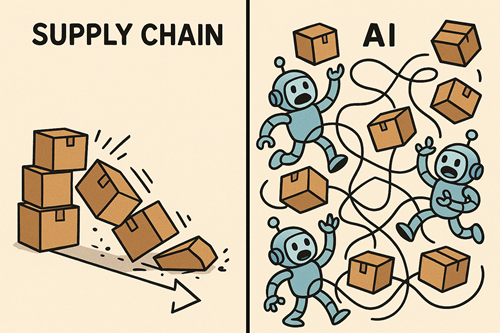Another great post by our guest editor, John Worthington.
“Supply chains are evolving into multi-agent systems, more like autonomous ecosystems than linear processes.” — Alberto Chierici
Let’s sit with that for a moment.
In his excellent post on Gradient’s recent multi-agent systems report, Alberto points out that the old image of a supply chain — neat, sequential, and predictable — is gone. We’re now in the age of intelligent supply networks: dynamic, adaptive, self-optimizing.
Think Amazon’s fulfillment centers or autonomous last-mile delivery systems. AI agents are acting on partial information, coordinating with other agents, and making real-time decisions — all at scale.
But here’s the problem: Who’s managing the managers?
When complexity increases faster than our ability to govern it, organizations reach for more tools, more dashboards, more specialized teams. But what they rarely reach for is a unified management system — one that provides a shared model for coordination, ownership, and continuous improvement across the entire value chain.
That’s where USM (Unified Service Management) enters the picture.
🧠 Why AI-Enhanced Supply Chains Need USM
Multi-agent supply systems are essentially distributed networks of services. Each AI agent — whether managing inventory, logistics, routing, or forecasting — performs a role in a larger service system. These systems must align to a common purpose: value delivery.
But without a unifying method:
- Each agent or subsystem operates with its own logic, increasing the risk of local optimization over global value.
- Coordination depends on fragile integrations or team heroics.
- Root cause analysis becomes a nightmare as agents “decide” and “act” autonomously.
- There is no shared language or structure across engineering, operations, and business teams.
USM tackles this head-on.
🔧 What USM Brings to the Table
USM provides a simple, scalable, and repeatable management architecture based on:
- 5 generic processes (AGREE, CHANGE, RESTORE, OPERATE, IMPROVE)
- 8 standardized workflows triggered by customer wishes, incidents, risks, and requests
- A common role model separating roles (who) from responsibilities (what)
- A service specification model that distinguishes between Facilities and Support, and Functionality and Functioning
This isn’t a toolkit or a platform. It’s a method, and that’s exactly what complex systems need.
With USM:
✅ You manage services, not tools or tasks ✅ You coordinate agents through structured workflows and roles ✅ You align AI behavior to business intent using service agreements, not just code ✅ You simplify governance and reduce risk across distributed supply networks
🧩 From Supply Chains to Service Ecosystems
AI-powered supply chains are no longer about procurement, warehousing, and delivery. They’re about coordinating autonomous value contributions — a system of systems. USM helps organizations shift from function silos to service logic, ensuring that:
- Teams speak the same language
- Automation enhances control, not chaos
- Value streams are transparent and improvable
In short, USM enables human governance of intelligent ecosystems.
🤝 Final Thought
AI in supply chains isn’t just a technical shift — it’s an organizational reckoning. As we delegate decisions to machines, we need to upgrade the system of management that ensures those decisions align with strategy, ethics, and customer value.
We'd better get our digital houses in order. The answer isn’t another platform. It’s a unifying method.
That’s what USM delivers.
[For more information about how USM addresses this, see the brief White Paper. Taming the Multi-Agent Supply Chain: How the USM Method Enables Oversight in Autonomous Ecosystems.]
==/==
![]() If you enjoyed John's post and it made you think about improving your own organization, please check out his USM Professional profile and his personal website, or better: contact John for a free consultation.
If you enjoyed John's post and it made you think about improving your own organization, please check out his USM Professional profile and his personal website, or better: contact John for a free consultation.
John has posted this blog earlier in his USM method News LinkedIN newsletter. If you want to read his posts when they're published - subscribe to John's channel.

